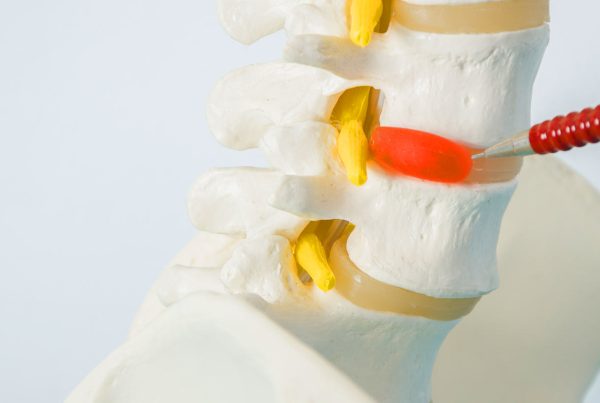Low back pain (LBP) is a common disorder involving the muscles, nerves, and bones of the back.[1] Pain can vary from a dull constant ache to a sudden sharp feeling.[1] Low back pain may be classified byduration as acute (pain lasting less than 6 weeks), sub-chronic (6 to 12 weeks), or chronic (more than 12 weeks).[2] The condition may be further classified by the underlying cause as either mechanical, non-mechanical, or referred pain.[3] The symptoms of low back pain usually improve within a few weeks from the time they start, with 40-90% of people completely better by six weeks.[4]
In most episodes of low back pain, a specific underlying cause is not identified or even looked for, with the pain believed to be due to mechanical problems such as muscle or joint strain.[1][5] If the pain does not go away with conservative treatment or if it is accompanied by “red flags” such as unexplained weight loss, fever, or significant problems with feeling or movement, further testing may be needed to look for a serious underlying problem.[3] In most cases, imaging tools such as X-ray computed tomography are not useful and carry their own risks.[6][7] Despite this, the use of imaging in low back pain has increased.[8] Some low back pain is caused by damaged intervertebral discs, and the straight leg raise test is useful to identify this cause.[3] In those with chronic pain, the pain processing system may malfunction, causing large amounts of pain in response to non-serious events.[9]
The treatment of acute nonspecific low back pain of rapid onset is typically with simple pain medications and the continuation of as much normal activity as the pain allows.[4] Medications are recommended for the duration that they are helpful, with paracetamol (also known as acetaminophen) as the preferred first medication.[10] A number of other options are available for those who do not improve with usual treatment.Opioids may be useful if simple pain medications are not enough, but they are not generally recommended due to side effects.[1][10] Surgery may be beneficial for those with disc-related chronic pain and disability orspinal stenosis.[11][12] No clear benefit has been found for other cases of non-specific low back pain.[11] Low back pain often affects mood, which may be improved by counseling or antidepressants.[10][13] Additionally, there are many alternative medicine therapies, including the Alexander technique and herbal remedies, but there is not enough evidence to recommend them confidently.[14] The evidence for chiropractic care[15]and spinal manipulation is mixed.[14][16][17][18]
Approximately 9 to 12% of people (632 million) have LBP at any given point in time, and nearly 25% report having it at some point over any one-month period.[19][20] About 40% of people have LBP at some point in their lives,[19] with estimates as high as 80% among people in the developed world.[21] Difficulty most often begins between 20 and 40 years of age.[5] Men and women are equally affected.[1] Low back pain is more common among people aged 40–80 years, with the overall number of individuals affected expected to increase as the population ages.[19]
Signs and symptoms
In the common presentation of acute low back pain, pain develops after movements that involve lifting, twisting, or forward-bending. The symptoms may start soon after the movements or upon waking up the following morning. The description of the symptoms may range from tenderness at a particular point to diffuse pain. It may or may not worsen with certain movements, such as raising a leg, or positions, such as sitting or standing. Pain radiating down the legs (known as sciatica) may be present. The first experience of acute low back pain is typically between the ages of 20 and 40. This is often a person’s first reason to see a medical professional as an adult.[5] Recurrent episodes occur in more than half of people[22] with the repeated episodes being generally more painful than the first.[5]
Other problems may occur along with low back pain. Chronic low back pain is associated with sleep problems, including a greater amount of time needed to fall asleep, disturbances during sleep, a shorter duration of sleep, and less satisfaction with sleep.[23]In addition, a majority of those with chronic low back pain show symptoms of depression[10] or anxiety.[14]
Causes
Low back pain is not a specific disease but rather a complaint that may be caused by a large number of underlying problems of varying levels of seriousness.[24] The majority of LBP does not have a clear cause[5] but is believed to be the result of non-serious muscle or skeletal issues such as sprains or strains.[25] Obesity, smoking, weight gain during pregnancy, stress, poor physical condition, poor posture and poor sleeping position may also contribute to low back pain.[25] A full list of possible causes includes many less common conditions.[3] Physical causes may include osteoarthritis, degeneration of the discs between the vertebrae or a spinal disc herniation, broken vertebra(e) (such as from osteoporosis) or, rarely, an infection or tumor of the spine.[26]
Women may have acute low back pain from medical conditions affecting the female reproductive system, including endometriosis, ovarian cysts, ovarian cancer, or uterine fibroids.[27] Nearly half of all pregnant women report pain in the lower back or sacral area during pregnancy, due to changes in their posture and center of gravity causing muscle and ligament strain.[28]
Low back pain can be broadly classified into four main categories:
- Musculoskeletal – mechanical (including muscle strain, muscle spasm, or osteoarthritis); herniated nucleus pulposus, herniated disk; spinal stenosis; or compression fracture
- Inflammatory – HLA-B27 associated arthritis including ankylosing spondylitis, reactive arthritis, psoriatic arthritis, and inflammatory bowel disease
- Malignancy – bone metastasis from lung, breast, prostate, thyroid, among others
- Infectious – osteomyelitis; abscess
Pathophysiology
Back structures
The lumbar (or lower back) region is made up of five vertebrae (L1-L5), sometimes including the sacrum. In between these vertebrae are fibrocartilaginous discs, which act as cushions, preventing the vertebrae from rubbing together while at the same time protecting the spinal cord. Nerves come from and go to the spinal cord through specific openings between the vertebrae, providing the skin with sensations and messages to muscles. Stability of the spine is provided by the ligaments and muscles of the back and abdomen. Small joints called facet joints limit and direct the motion of the spine.[29]
The multifidus muscles run up and down along the back of the spine, and are important for keeping the spine straight and stable during many common movements such as sitting, walking and lifting.[9] A problem with these muscles is often found in someone with chronic low back pain, because the back pain causes the person to use the back muscles improperly in trying to avoid the pain.[30] The problem with the multifidus muscles continues even after the pain goes away, and is probably an important reason why the pain comes back.[30] Teaching people with chronic low back pain how to use these muscles is recommended as part of a recovery program.[30]
An intervertebral disc has a gelatinous core surrounded by a fibrous ring.[31] When in its normal, uninjured state, most of the disc is not served by either the circulatory or nervous systems – blood and nerves only run to the outside of the disc.[31] Specialized cells that can survive without direct blood supply are in the inside of the disc.[31] Over time, the discs lose flexibility and the ability to absorb physical forces.[24] This decreased ability to handle physical forces increases stresses on other parts of the spine, causing the ligaments of the spine to thicken and bony growths to develop on the vertebrae.[24] As a result, there is less space through which the spinal cord and nerve roots may pass.[24] When a disc degenerates as a result of injury or disease, the makeup of a disc changes: blood vessels and nerves may grow into its interior and/or herniated disc material can push directly on a nerve root.[31] Any of these changes may result in back pain.[31]
Pain sensation
Pain is generally an unpleasant feeling in response to an event that either damages or can potentially damage the body’s tissues. There are four main steps in the process of feeling pain: transduction, transmission, perception, and modulation.[9] The nerve cells that detect pain have cell bodies located in the dorsal root ganglia and fibers that transmit these signals to the spinal cord.[32] The process of pain sensation starts when the pain-causing event triggers the endings of appropriate sensory nerve cells. This type of cell converts the event into an electrical signal by transduction. Several different types of nerve fibers carry out the transmission of the electrical signal from the transducing cell to the posterior horn of spinal cord, from there to the brain stem, and then from the brain stem to the various parts of the brain such as the thalamus and the limbic system. In the brain, the pain signals are processed and given context in the process of pain perception. Through modulation, the brain can modify the sending of further nerve impulses by decreasing or increasing the release of neurotransmitters.[9]
Parts of the pain sensation and processing system may not function properly; creating the feeling of pain when no outside cause exists, signaling too much pain from a particular cause, or signaling pain from a normally non-painful event. Additionally, the pain modulation mechanisms may not function properly. These phenomena are involved in chronic pain.[9]
Diagnosis
As the structure of the back is complex and the reporting of pain is subjective and affected by social factors, the diagnosis of low back pain is not straightforward.[3] While most low back pain is caused by muscle and joint problems, this cause must be separated from neurological problems, spinal tumors, fracture of the spine, and infections, among others.[2][5]
Classification
There are a number of ways to classify low back pain with no consensus that any one method is best.[3] There are three general types of low back pain by cause: mechanical back pain (including nonspecific musculoskeletal strains, herniated discs, compressed nerve roots, degenerative discs or joint disease, and broken vertebra), non-mechanical back pain (tumors, inflammatory conditions such as spondyloarthritis, and infections), and referred pain from internal organs (gallbladder disease, kidney stones, kidney infections, and aortic aneurysm, among others).[3] Mechanical or musculoskeletal problems underlie most cases (around 90% or more),[3][33] and of those, most (around 75%) do not have a specific cause identified, but are thought to be due to muscle strain or injury to ligaments.[3][33] Rarely, complaints of low back pain result from systemic or psychological problems, such as fibromyalgia and somatoform disorders.[33]
Low back pain may be classified based on the signs and symptoms. Diffuse pain that does not change in response to particular movements, and is localized to the lower back without radiating beyond the buttocks, is classified as nonspecific, the most common classification.[3] Pain that radiates down the leg below the knee, is located on one side (in the case of disc herniation), or is on both sides (in spinal stenosis), and changes in severity in response to certain positions or maneuvers is radicular, making up 7% of cases.[3] Pain that is accompanied by red flags such as trauma, fever, a history of cancer or significant muscle weakness may indicate a more serious underlying problem and is classified as needing urgent or specialized attention.[3]
The symptoms can also be classified by duration as acute, sub-chronic (also known as sub-acute), or chronic. The specific duration required to meet each of these is not universally agreed upon, but generally pain lasting less than six weeks is classified asacute, pain lasting six to twelve weeks is sub-chronic, and more than twelve weeks is chronic.[2] Management and prognosis may change based on the duration of symptoms.
Prevention
Exercise appears to be useful for preventing low back pain.[45] Exercise is also probably effective in preventing recurrences in those with pain that has lasted more than six weeks.[5][46] Medium-firm mattresses are more beneficial for chronic pain than firm mattresses.[47] There is little to no evidence that back belts are any more helpful in preventing low back pain than education about proper lifting techniques.[45][48] Shoe insoles do not help prevent low back pain.[45][49]
Management
Management of low back pain depends on which of the three general categories is the cause: mechanical problems, non-mechanical problems, or referred pain.[50] For acute pain that is causing only mild to moderate problems, the goals are to restore normal function, return the individual to work, and minimize pain. The condition is normally not serious, resolves without much being done, and recovery is helped by attempting to return to normal activities as soon as possible within the limits of pain.[2] Providing individuals with coping skills through reassurance of these facts is useful in speeding recovery.[5] For those with sub-chronic or chronic low back pain, multidisciplinary treatment programs may help.[51]
Physical management
Increasing general physical activity has been recommended, but no clear relationship to pain or disability has been found when used for the treatment of an acute episode of pain.[46][52] For acute pain, low- to moderate-quality evidence supports walking.[53] Treatment according to McKenzie method is somewhat effective for recurrent acute low back pain, but its benefit in the short term does not appear significant.[5] There is tentative evidence to support the use of heat therapy for acute and sub-chronic low back pain[54] but little evidence for the use of either heat or cold therapy in chronic pain.[55] Weak evidence suggests that back belts might decrease the number of missed workdays, but there is nothing to suggest that they will help with the pain.[48] Ultrasound and shock wave therapies do not appear effective and therefore are not recommended.[56][57]
Exercise therapy is effective in decreasing pain and improving function for those with chronic low back pain.[48] It also appears to reduce recurrence rates for as long as six months after the completion of program[58] and improves long-term function.[55] There is no evidence that one particular type of exercise therapy is more effective than another.[59] The Alexander technique appears useful for chronic back pain,[60] and there is tentative evidence to support the use of yoga.[61] Transcutaneous electrical nerve stimulation (TENS) has not been found to be effective in chronic low back pain.[62] Evidence for the use of shoe insoles as a treatment is inconclusive.[49] Peripheral nerve stimulation, a minimally-invasive procedure, may be useful in cases of chronic low back pain that do not respond to other measures, although the evidence supporting it is not conclusive, and it is not effective for pain that radiates into the leg.[63]
Medications
The management of low back pain often includes medications for the duration that they are beneficial. With the first episode of low back pain the hope is a complete cure; however, if the problem becomes chronic, the goals may change to pain management and the recovery of as much function as possible. As pain medications are only somewhat effective, expectations regarding their benefit may differ from reality, and this can lead to decreased satisfaction.[10]
The medication typically recommended first is acetaminophen (paracetamol) or NSAIDs (though not aspirin), and these are enough for most people. Standard doses of acetaminophen are very safe; however, high doses may cause liver problems, and very high doses can be fatal.[10] High-quality reviews have found acetaminophen (paracetamol) to be no more effective than placebo at improving pain, quality of life, or function.[64][65] NSAIDs are more effective for acute episodes than acetaminophen; however, they carry a greater risk of side effects including: kidney failure, stomach ulcers and possibly heart problems. Thus, NSAIDs are a second choice to acetaminophen, recommended only when the pain is not handled by the latter. NSAIDs are available in several different classes; there is no evidence to support the use of COX-2 inhibitors over any other class of NSAIDs with respect to benefits.[10][66] With respect to safety naproxen may be best.[67] Muscle relaxants may be beneficial.[10]
If the pain is still not managed adequately, short term use of opioids such as morphine may be useful.[68] These medications carry a risk of addiction, may have negative interactions with other drugs, and have a greater risk of side effects, including dizziness, nausea, and constipation. Opioids may be suitable for short-term management of severe, acute pain that is causing significant problems.[10] Specialist groups advise against general long-term use of opioids for chronic low back pain.[10][69]
For older people with chronic pain, opioids may be used in those for whom NSAIDs present too great a risk, including those with diabetes, stomach or heart problems. They may also be useful for a select group of people with neuropathic pain.[70]
Antidepressants may be effective for treating chronic pain associated with symptoms of depression, but they have a risk of side effects. Although the antiseizure drugs gabapentin and carbamazepine are sometimes used for chronic low back pain and may relieve sciatic pain, there is insufficient evidence to support their use.[10] Systemic oral steroids have not been shown to be useful in low back pain.[5][10] Facet joint injections and steroid injections into the discs have not been found to be effective in those with persistent, non-radiating pain; however, they may be considered for those with persistent sciatic pain.[71] Epidural corticosteroid injections provide a slight and questionable short-term improvement in those with sciatica but are of no long term benefit.[72] There are also concerns of potential side effects.[73]
Surgery
Surgery may be useful in those with a herniated disc that is causing significant pain radiating into the leg, significant leg weakness, bladder problems, or loss of bowel control.[11] It may also be useful in those with spinal stenosis.[12] In the absence of these issues, there is no clear evidence of a benefit from surgery.[11]
Discectomy (the partial removal of a disc that is causing leg pain) can provide pain relief sooner than nonsurgical treatments.[11] Discectomy has better outcomes at one year but not at four to ten years.[11] The less invasive microdiscectomy has not been shown to result in a different outcome than regular discectomy.[11] For most other conditions, there is not enough evidence to provide recommendations for surgical options.[11] The long-term effect surgery has on degenerative disc disease is not clear.[11] Less invasive surgical options have improved recovery times, but evidence regarding effectiveness is insufficient.[11]
For those with pain localized to the lower back due to disc degeneration, fair evidence supports spinal fusion as equal to intensive physical therapy and slightly better than low-intensity nonsurgical measures.[12] Fusion may be considered for those with low back pain from acquired displaced vertebra that does not improve with conservative treatment,[11] although only a few of those who have spinal fusion experience good results.[12] There are a number of different surgical procedures to achieve fusion, with no clear evidence of one being better than the others.[74] Adding spinal implant devices during fusion increases the risks but provides no added improvement in pain or function.[8]
Alternative medicine
It is unclear if chiropractic care or spinal manipulation therapy (SMT) improves outcomes in those with low back pain more or less than other treatments.[15] Some reviews find that SMT results in equal or better improvements in pain and function when compared with other commonly used interventions for short, intermediate, and long-term follow-up;[16][17] other reviews find it to be no more effective in reducing pain than either inert interventions, sham manipulation, or other treatments, and conclude that adding SMT to other treatments does improve outcomes.[14][18] National guidelines reach different conclusions, with some not recommending spinal manipulation, some describing manipulation as optional, and others recommending a short course for those who do not improve with other treatments.[2] Manipulation under anaesthesia, or medically assisted manipulation, has not enough evidence to make any confident recommendation.[75]
Acupuncture is no better than placebo, usual care, or sham acupuncture for nonspecific acute pain or sub-chronic pain.[76] For those with chronic pain, it improves pain a little more than no treatment and about the same as medications, but it does not help with disability.[76] This pain benefit is only present right after treatment and not at follow-up.[76] Acupuncture may be a reasonable method to try for those with chronic pain that does not respond to other treatments like conservative care and medications.[5][77]
While massage therapy does not appear to provide much benefit for acute low back pain,[5] it may help those with sub-chronic and chronic pain, particularly when combined with physical exercises and education.[78] Tentative evidence suggests that acupuncture and massage together may be better than massage alone.[78]
Prolotherapy – the practice of injecting solutions into joints (or other areas) to cause inflammation and thereby stimulate the body’s healing response – has not been found to be effective by itself, although it may be helpful when added to another therapy.[14]
Herbal medicines, as a whole, are poorly supported by evidence.[79] The herbal treatments Devil’s claw and white willow may reduce the number of individuals reporting high levels of pain; however, for those taking pain relievers, this difference is not significant.[14] Capsicum, in the form of either a gel or a plaster cast, has been found to reduce pain and increase function.[14]
Behavioral therapy may be useful for chronic pain.[13] There are several types available, including operant conditioning, which uses reinforcement to reduce undesirable behaviors and increase desirable behaviors; cognitive behavioral therapy, which helps people identify and correct negative thinking and behavior; and respondent conditioning, which can modify an individual’s physiological response to pain. Medical providers may develop an integrated program of behavioral therapies.[14] The evidence is inconclusive as to whether mindfulness-based stress reduction reduces chronic back pain intensity or associated disability, although it suggests that it may be useful in improving the acceptance of existing pain.[80]
Tentative evidence supports neuroreflexotherapy (NRT), in which small pieces of metal are placed just under the skin of the ear and back, for non-specific low back pain.[81][82]
Prognosis
Overall, the outcome for acute low back pain is positive. Pain and disability usually improve a great deal in the first six weeks, with complete recovery reported by 40 to 90%.[4] In those who still have symptoms after six weeks, improvement is generally slower with only small gains up to one year. At one year, pain and disability levels are low to minimal in most people. Distress, previous low back pain, and job satisfaction are predictors of long-term outcome after an episode of acute pain.[4] Certain psychological problems such as depression, or unhappiness due to loss of employment may prolong the episode of low back pain.[10] Following a first episode of back pain, recurrences occur in more than half of people.[22]
For persistent low back pain, the short-term outcome is also positive, with improvement in the first six weeks but very little improvement after that. At one year, those with chronic low back pain usually continue to have moderate pain and disability.[4] People at higher risk of long-term disability include those with poor coping skills or with fear of activity (2.5 times more likely to have poor outcomes at one year),[83] those with a poor ability to cope with pain, functional impairments, poor general health, or a significant psychiatric or psychological component to the pain (Waddell’s signs).[83]
Article By Wikipedia



